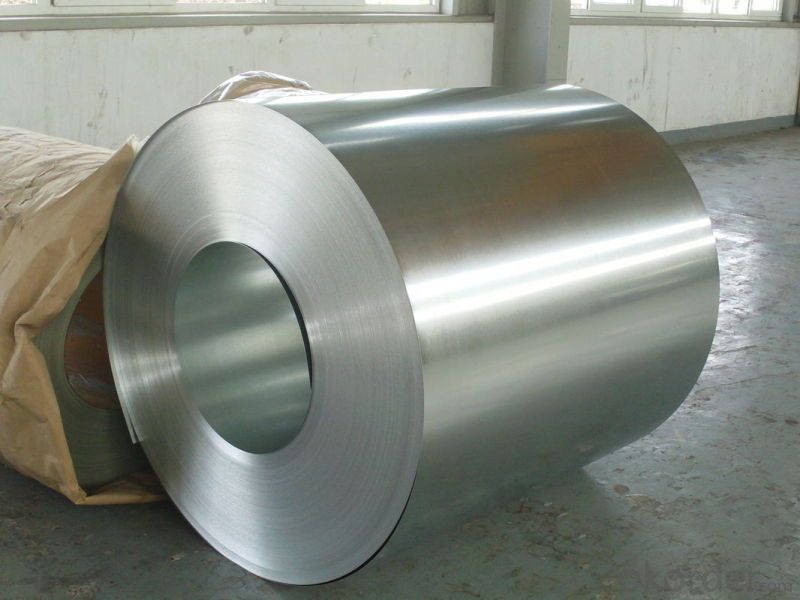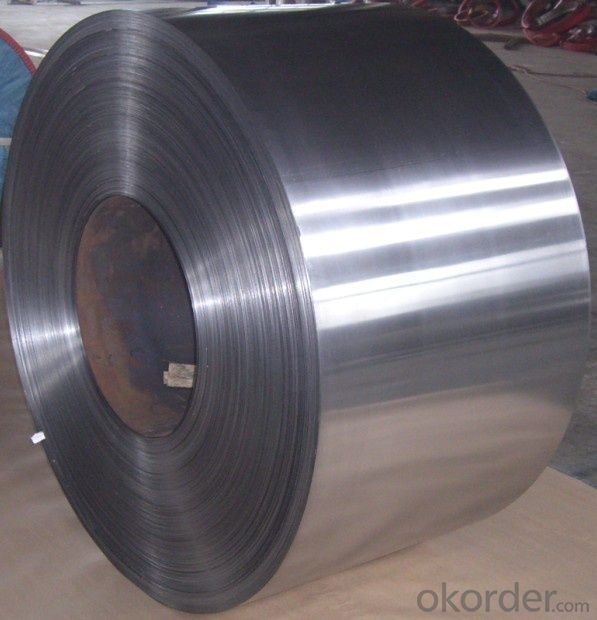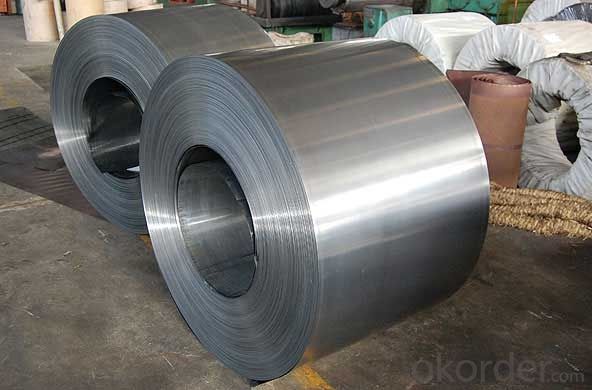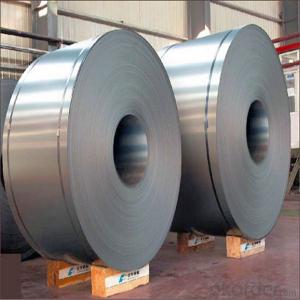Prime Cold Rolled Steel Coils with Low Price
- Loading Port:
- China main port
- Payment Terms:
- TT OR LC
- Min Order Qty:
- 10 m.t.
- Supply Capability:
- 50000 m.t./month
OKorder Service Pledge
OKorder Financial Service
You Might Also Like
Item specifice
Product Description
Cold Rolled Steel Coil
1.Thickness:0.18-1.8mm
2.Width:700-1300mm
3.Length:as your need
4.Inner Diameter: 508mm
5.Weight of Steel Coil: 3-15MT
6.Heat Treatment: Annealed
7.Surface Quality: FB&FC
8.Surface Status: SB & SD
9.Surface Treatment: Oiling
10.Standard:AISI, ASTM, BS, DIN, GB, JIS
11.Grade:SPCC/SPCD/SPCE/ST12-15/DC01-06.
12.Delivery time:15-20days after receipting the advance payment.
13.Package: Standard export packing or as your requested.
14.Technique:
15.Surface Treatmentunoil,dry,chromate passivated, non-chromate passivated
16.Application:Widely used in ships, automobiles, bridges, buildings, machinery, etc
17.Price terms: FOB CIF CFR
18.Payment : T/T or L/C at sight
19.Samples are available
| 1. Material | SPCC;SPCD;SPCE; DC01;DC02;DC03; ST12/ST13/ST14 |
| 2.Standard | ASTM ;BS;JIS;DIN;GB |
| 3. Inner Diameter | 508mm/610mm |
| 4. Length | can be done as your requirements. |
| 5. Thickness | 0.13mm-4.0mm (W.T tolerance ±1%) |
| 6.Width | Strip:20-600mm |
| 7.Coil weight | 1-3 tons |
| 8.Surface | Oiled;Skin-passed;passivation |
| 9.End | EC/EM |
| 10.Technology | Cold rolled/annealing |
| 11.related products | Gi sheet |
| 12.Usage | common structural parts and parts for drawing in engineering machines transportation machine construction machines, lifting machine, agricultural machines, light and civil industrial, household appliance industries. chemical equipments, drive casing pipe and light industrial civil industries. |



- Q:What is the process of uncoiling steel coils?
- The process of uncoiling steel coils involves unwinding the tightly wound steel coils using specialized equipment such as uncoiling machines or decoilers. These machines utilize hydraulic or mechanical systems to hold the coil securely while gradually releasing the tension on the coil. As the coil is released, it starts to unwind, with the steel strip gradually straightening out. This process allows for the easy feeding of the steel strip into further production processes such as cutting, stamping, or forming.
- Q:What are the common coil transportation methods?
- The common coil transportation methods include using flatbed trucks, coil racks, coil cars, and coil trailers.
- Q:How are steel coils used in the production of metal furniture?
- Steel coils are used in the production of metal furniture as they serve as the primary raw material for manufacturing various components such as frames, legs, and supports. These coils are unwound and processed through cutting, bending, and shaping techniques to create the desired shapes and sizes. Additionally, steel coils provide the necessary strength and durability to ensure the longevity and stability of the final furniture products.
- Q:Hi! does anyone know where can i find a building with a structure of steel frames, i need to do an analysis for school so i need joint details, girder details and such! PLEASE help me! thanks
- if u need to analyse a steel framed structure for joint details the best example would be of a mechanic workshop...the truss of such a workshop is always supported on a portal frame and in most of the case thats a steel structure...do keenly observe the joints at the footing plates that is connected to the girder section...nd also observe the joints in truss of such a frame....myslf m a civil engg. student.
- Q:I'm writing a story, and trying to find out how hot it needs to be for steel to turn into a gas.
- Steel is to broad. There are many types of steel with different melting/boiling points. Iron* has a boiling point of 5182 °F and a Heat of vaporization of 340 kJ·mol?1. iron is the main ingredient of steel, along with carbon and other various elements.
- Q:Why does steel with several composites have a greater hardenability from quenching than low carbon steel alloys?Any help would be great
- Bit tricky to explain and I don't know muh about it but steel on its own has lost of gaps in it ( the molecular structure) and when carbon is added thos gaps are filled, I think of it like this: it is easier to punch through expanded polystyrene( with all the little balls) than unexpanded(just a lump of plastic) as the balls are not properly joined and have air pockets between them.
- Q:Ik iron was too heavy but could steel bolts have been used. I can see iron dissolving at surface when to be a danger it needs to reach the core of sun.. But so does steel go deeper in(w.e alloy turned from iron)..I wanna know which would be worse iron..or upgraded iron(steel) and if the steel would have worse effects than normal iron..Im sure if we used iron we used steel
- Steel might have been used in some bolts sure. But.....are you under the impression that Ulysses was ever intended to crash into the Sun or something? You know it wasn't right? It was launched (in the 1980's) to study the Sun. But....uh.....not by crashing into it. Ulysses was even sent out to use Jupiter as a gravitational assist. We are closer to the Sun than Ulysses is..... Even if it did go crash into the Sun though there is absolutely no way that ANY material, natural or manmade, could survive intact all the way to the core of a star. It takes photons of LIGHT something like 100,000 years just to make it out from the core of the Sun to the surface because it is so dense. How do you propose a metal probe making it back the other way? Would it have worse effects than what? The effects, no matter what it was made out of, would be that as it got CLOSE to the Sun it would vaporize. No matter what it was made out of though it would have no affect whatsoever on the Sun. Every single element, without exception, that exists on the Earth and everywhere else in our solar system also exists in the Sun already, in far greater quantities. The planets and Sun all formed out of the same nebula at the same time. The Sun just got massive enough that fusion began and it became a star. There is already more iron in the Sun than there is everything on Earth. If you took every single atom of every element there is on the Earth it would still not add up to even a fraction of the total amount of iron in the Sun.
- Q:What are the common applications of hot-dip galvanized steel coils?
- Hot-dip galvanized steel coils are widely utilized across various industries due to their exceptional resistance to corrosion and long-lasting durability. These coils find numerous applications in different sectors, including construction, automotive, appliances, agriculture, electrical and telecommunication, transportation, and industrial sectors. The following are some of the common uses of hot-dip galvanized steel coils: 1. Construction: The construction industry extensively relies on hot-dip galvanized steel coils for applications like roofing, siding, gutters, and downspouts. The coils' corrosion resistance ensures that structures can withstand harsh weather conditions, resulting in low-maintenance and long-lasting buildings. 2. Automotive: In the automotive sector, hot-dip galvanized steel coils are widely employed for manufacturing body panels, frames, chassis, and structural components. These coils provide enhanced protection against rust and offer high strength, ensuring the longevity of automotive parts. 3. Appliances: Hot-dip galvanized steel coils are utilized in the production of various household appliances such as refrigerators, air conditioners, ovens, and washing machines. The coils' corrosion resistance and aesthetic appeal make them an ideal choice for these appliances. 4. Agriculture: The agricultural sector commonly uses hot-dip galvanized steel coils for constructing greenhouses, livestock shelters, fences, and irrigation systems. The galvanized coating protects the steel from corrosion caused by exposure to moisture and chemicals commonly found in agricultural settings. 5. Electrical and Telecommunication: The electrical and telecommunication industries employ hot-dip galvanized steel coils for manufacturing transmission towers, poles, cable trays, and electrical conduits. These coils' corrosion resistance and high strength ensure the safety and reliability of these infrastructure components. 6. Transportation: Hot-dip galvanized steel coils play a significant role in the transportation industry, particularly in manufacturing trailers, shipping containers, and chassis components. The galvanized coating provides protection against corrosion caused by road salt, moisture, and various environmental factors. 7. Industrial Applications: Hot-dip galvanized steel coils are widely used in various industrial applications, including storage tanks, pipelines, ductwork, and industrial equipment. The coils' corrosion resistance and durability ensure the integrity and longevity of these structures and equipment. In conclusion, hot-dip galvanized steel coils have a wide range of applications in industries such as construction, automotive, appliances, agriculture, electrical and telecommunication, transportation, and industrial sectors. The coils' corrosion resistance, durability, and aesthetic appeal make them a versatile and extensively used material in these applications.
- Q:How can the quality of steel coils be ensured?
- The quality of steel coils can be ensured through various measures such as regular testing and inspection, adherence to industry standards and specifications, quality control processes during manufacturing, and certification from reputable third-party organizations. Additionally, proper handling, storage, and transportation practices play a crucial role in maintaining the quality of steel coils.
- Q:How are steel coils used in the manufacturing of industrial compressors?
- Steel coils are used in the manufacturing of industrial compressors primarily for the construction of the compressor's casing and frame. The steel coils are shaped, cut, and welded to create the sturdy and durable structure that houses the compressor components. Additionally, the steel coils may also be used in the fabrication of other parts such as motor mounts or brackets, contributing to the overall reliability and stability of the compressor.
1. Manufacturer Overview |
|
|---|---|
| Location | |
| Year Established | |
| Annual Output Value | |
| Main Markets | |
| Company Certifications | |
2. Manufacturer Certificates |
|
|---|---|
| a) Certification Name | |
| Range | |
| Reference | |
| Validity Period | |
3. Manufacturer Capability |
|
|---|---|
| a)Trade Capacity | |
| Nearest Port | |
| Export Percentage | |
| No.of Employees in Trade Department | |
| Language Spoken: | |
| b)Factory Information | |
| Factory Size: | |
| No. of Production Lines | |
| Contract Manufacturing | |
| Product Price Range | |
Send your message to us
Prime Cold Rolled Steel Coils with Low Price
- Loading Port:
- China main port
- Payment Terms:
- TT OR LC
- Min Order Qty:
- 10 m.t.
- Supply Capability:
- 50000 m.t./month
OKorder Service Pledge
OKorder Financial Service
Similar products
New products
Hot products
Hot Searches
Related keywords




























